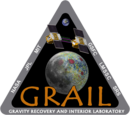GRAIL mission

Artist's interpretation of the GRAIL tandem spacecraft above the lunar surface.
|
|
| Operator | NASA / JPL |
|---|---|
| COSPAR ID | 2011-046 (A, B) |
| SATCAT no. | 37801, 37802 |
| Website | moon |
| Mission duration | 9 months |
| Spacecraft properties | |
| Manufacturer | Massachusetts Institute of Technology, LMSS |
| Launch mass | 307 kg (677 lb) |
| Dry mass | 132.6 kg (292 lb) |
| Power | (Solar array / Li-ion battery) |
| Start of mission | |
| Launch date | September 10, 2011, 13:08:52.775 UTC |
| Rocket | Delta II 7920H-10 D-356 |
| Launch site | Cape Canaveral SLC-17B |
| Entered service | December 31, 2011 (Ebb) January 1, 2012 (Flow) |
| Orbital parameters | |
| Reference system | Selenocentric |
| Regime | Polar orbit |
| Semi-major axis | 1,788.0 kilometres (1,111.0 mi) |
| Periselene | 25 kilometres (16 mi) |
| Aposelene | 86 kilometres (53 mi) |
| Period | 113 minutes |
| Lunar impactor | |
| Impact date | December 17, 2012, 22:28:51 UTC |
| Impact site | 75°36′30″N 33°24′15″E / 75.6083°N 33.4043°E |
| Lunar impactor | |
| Impact date | December 17, 2012, 22:29:21 UTC |
| Impact site | 75°39′01″N 33°09′51″E / 75.6504°N 33.1643°E |
|
|
|
The Gravity Recovery and Interior Laboratory (GRAIL) was an American lunar science mission in NASA's Discovery Program which used high-quality gravitational field mapping of the Moon to determine its interior structure. The two small spacecraft GRAIL A (Ebb) and GRAIL B (Flow) were launched on 10 September 2011 aboard a single launch vehicle: the most-powerful configuration of a Delta II, the 7920H-10. GRAIL A separated from the rocket about nine minutes after launch, GRAIL B followed about eight minutes later. They arrived at their orbits around the Moon 25 hours apart. The first probe entered orbit on 31 December 2011 and the second followed on 1 January 2012. The two spacecraft impacted the Lunar surface on December 17, 2012.
Maria Zuber of the Massachusetts Institute of Technology is GRAIL's principal investigator. NASA's Jet Propulsion Laboratory manages the project. As of August 5, 2011[update], the program has cost US$496 million. Upon launch the spacecraft were named GRAIL A and GRAIL B and a contest was opened to school children to select names. Nearly 900 classrooms from 45 states, Puerto Rico and the District of Columbia, participated in the contest. The winning names, Ebb and Flow, were suggested by 4th grade students at Emily Dickinson Elementary School in Bozeman, Montana.
Each spacecraft transmitted and received telemetry from the other spacecraft and Earth-based facilities. By measuring the change in distance between the two spacecraft, the gravity field and geological structure of the Moon was obtained. The two spacecraft were able to detect very small changes in the distance between one another. Changes in distance as small as one micron were detectable and measurable. The gravitational field of the Moon was mapped in unprecedented detail.
...
Wikipedia

